#Melting Caves
Text

Mahesh Magar, a guide with Himalayan Research Expeditions, exits a cave on the Khumbu Glacier, just a short walk from Everest Base Camp. With elevations of more than 17,500 feet above sea level, these are some of the highest mapped caves in the world. Caves like this one are forming in high altitude Himalayan glaciers as soaring temperatures send more meltwater cascading through the insides of glaciers, melting tunnels that are literally rotting glaciers from the inside out.
These Caves Mean Death For Himalayan Glaciers
Otherworldly Ice Caves are Rotting the Glaciers From the Inside Out, Putting Villages Below in the Path of Devastating Potential Flash Floods.
— By Douglas Fox | Photographs By Jason Gulley | January 10, 2024
Jason Gulley has spent 19 years crawling through the insides of glaciers, from Alaska to Nepal. Sometimes these caves, carved through the ice by running water, are large enough for a truck to drive through. Other times, they’re so narrow that he slides along the slippery floor on his belly. If he pauses, his clothing can freeze to the ice.
Gulley is a geologist at the University of South Florida, who began his career studying limestone caverns. It was only by chance that he started exploring the insides of glaciers. The first time he entered one of these caves in the Mount Everest Region, on Lhotse Glacier, was a harrowing experience.
He and his companion stood outside the entrance, watching basketball-sized rocks rain down from the unstable ice cliff overhead. After gathering his wits, he sprinted inside—followed a moment later by Douglas Benn, a veteran Himalayan Glaciologist from the University of St. Andrews in Scotland.
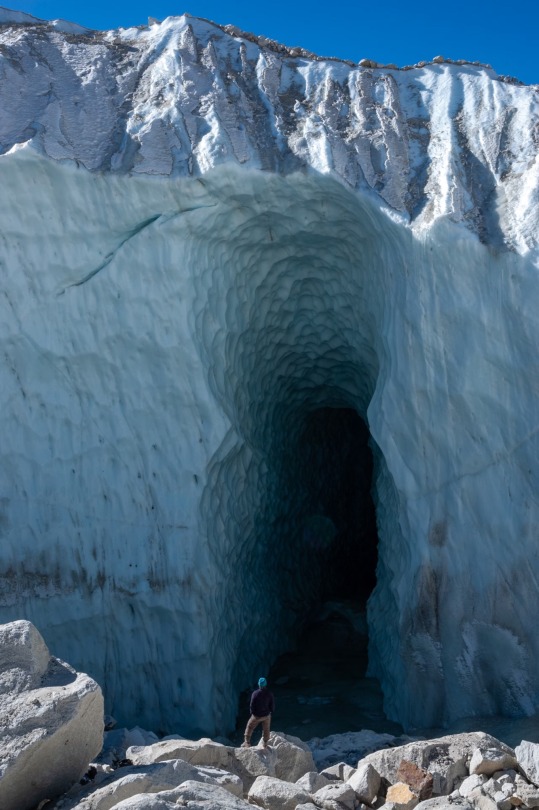
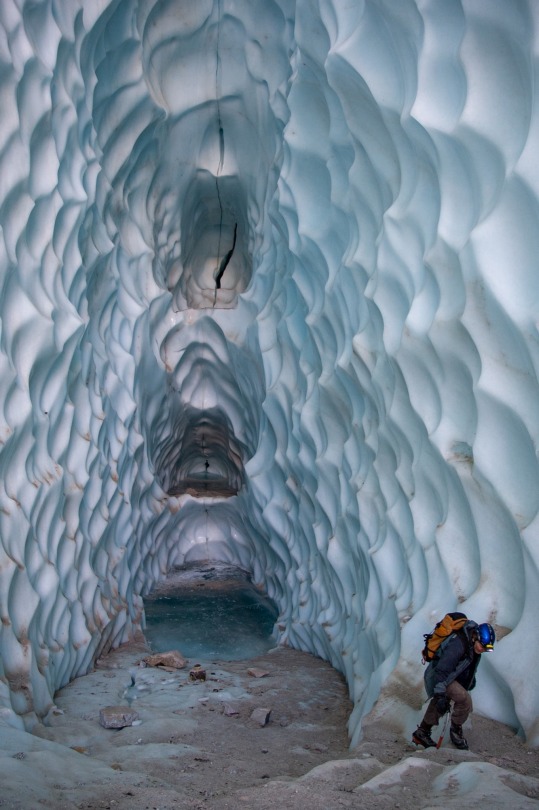
Left: Glaciologist Doug Benn enters a massive cave on the Khumbu Glacier in December 2006. This cave formed as ponds of melted water, sitting on top of glaciers, elevated water pressured and punched open the cracks, causing lake water to surge into the surrounding ice. Right: As the mountainous region warms, these ponds of melted water are becoming more common, hastening the demise of frozen glaciers.
After a few minutes in the cave, they accidentally triggered a minor collapse. The brittle ceiling shattered in a rain of ice shards. “That’s when it really started to dawn on us,” says Gulley. “We really have no idea of what could kill us in here.”
In the years since, Gulley, Benn, and several other scientists have managed to explore these little-known caves. Their work has laid bare the private lives of glaciers—and the disease that is rapidly consuming them.
Glaciers in the Himalaya are thinning by up to nine feet per year, and these caves are playing a pivotal role, hollowing out and collapsing the ice from within.
“It’s the cancer that’s eating what’s left of the glacier,” says Gulley.
As the world warms, the tongues of these glaciers are melting into large lakes, which threaten to unleash flash floods upon villages in the valleys below.
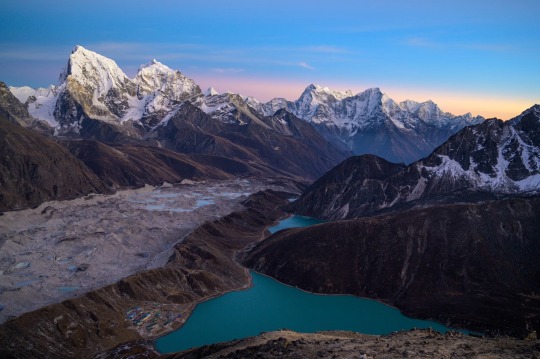
The Sherpa settlement of Gokyo lies beneath the rapidly disappearing Ngozumpa Glacier. Like nearly half of the glaciers in Nepal's Everest Region, the Ngozumpa Glacier is covered in rocky debris shed by adjacent mountains.
Little-explored Caves
Glaciers in the Himalaya differ from what most people imagine. Stand at the lower end of Ngozumpa Glacier, which flows from 26,864-foot Cho Oyu, the world’s sixth-highest mountain, and you will see what appears to be a jumble of rocks filling the valley.
Ngozumpa, like many Himalayan glaciers, is fed by avalanches that sweep down from above—depositing snow, rocks, and boulders onto its upper reaches.
As the glacier descends into warmer air, its surface starts to melt. This removes the upper layers of ice, bringing the buried rubble back to surface. There it accumulates in a layer, up to four feet thick, covering the glacier.
Many Himalayan glaciers are “debris-covered,” like Ngozumpa, and scientists believed that this would insulate them from warming temperatures. But it hasn’t worked out that way, says Teiji Watanabe, a geomorphologist at Hokkaido University in Japan, who has frequently visited the Everest Region since the late 1980s.
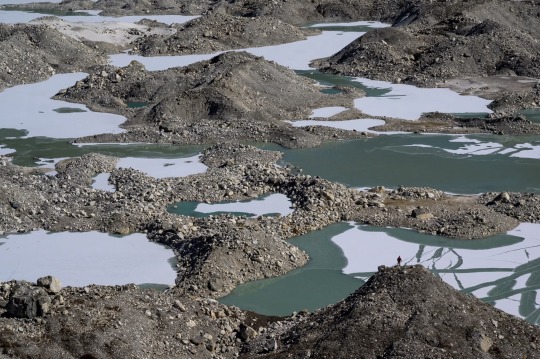
Melting water forms pools on the debris-covered Ngozumpa Glacier, in the Everest region of Nepal. Lakes like these heat up during summer and provide large sources of relatively warm water that can carve cave passages into the ice by melting the layers of ice below.
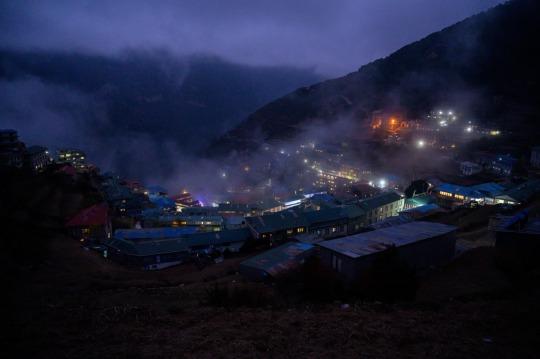
Electric lights in the Sherpa capitol of Namche Bazaar light up the night sky. Namche Bazaar and other nearby Sherpa settlements receive electricity from a small hydroelectric power plant. Infrastructure like this is vulnerable to floods from overlowing glacier lakes.
In the past few decades, the surface of Ngozumpa and other debris-covered glaciers has become pocked with thousands of sinkholes up to 100 feet deep, as the ice shrinks beneath the rocks. Melt ponds frequently fill these depressions. The total area of these ponds has tripled in 30 years—a rate of change that “is really, really amazing,” says Watanabe.
The cause of that rapid change was a mystery. But around the year 2000 Benn, the Scottish glaciologist, noticed a clue.
Melt ponds on Ngozumpa and other debris-covered glaciers often disappeared overnight. At the bottom of these empty depressions, Benn found cave openings, through which the lake had drained.
No one knew how extensive those caves were, or where they went.
But in 2004, Benn met Gulley—an accomplished caver—through a mutual friend.
Benn’s photos of gaping cave openings and pitted glaciers reminded Gulley of limestone landscapes in the Caribbean, where thousands of sinkholes had formed as caves collapsed beneath the surface. With Gulley’s expertise, they entered their first glacier cave in the Everest Region, in 2005.
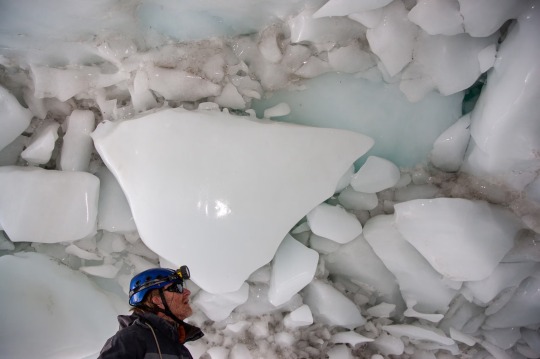
Glaciologist Doug Benn examines the roof of a glacier cave on Nepal's Khumbu Glacier. The entire cave roof consists of blocks of shattered ice that had been frozen together.
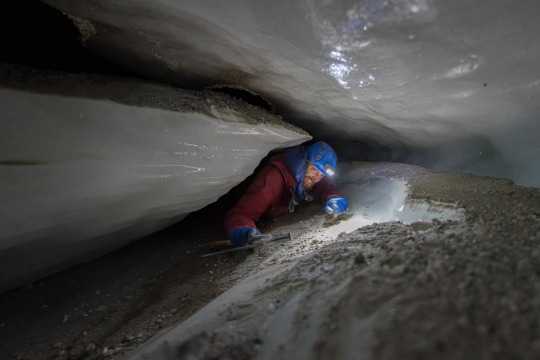
Glacier researcher Matt Covington moves through a tight section of a cave inside the Ngozumpa Glacier, during a 2018 expedition. Crawling at altitudes between 15,000 and 18,000 feet above sea level is one of the most physically demanding parts of cave exploration.
A Downward Spiral of Melting Caves
As they ventured into the darkness, the beams from their headlamps illuminated the fog of their breath. Thin layers of dust, as fine as flour, coated the surfaces — “as if the cave was a store that went out of business 30 years ago,” says Gulley.
They hurried out of that first cave after part of its ceiling collapsed.
Their second cave entry, several days later, didn’t go much better. As they walked down a passage, their spiked crampons crackling on the ice, Gulley suddenly plunged through the floor.
Only later did they realize they’d been walking on a false floor—a veneer of ice, three quarters of an inch thick, that had formed on top of standing water. That water later drained out from below—leaving the five-foot void that Gulley fell into.
They gradually learned to avoid these hazards. And as they explored Ngozumpa Glacier, year after year, Gulley was amazed at how these meandering ice caves resembled limestone caverns—except in the glacier, the ornate scallops, grooves, stalagmites, and stalactites had formed in a few months, rather than thousands of years.
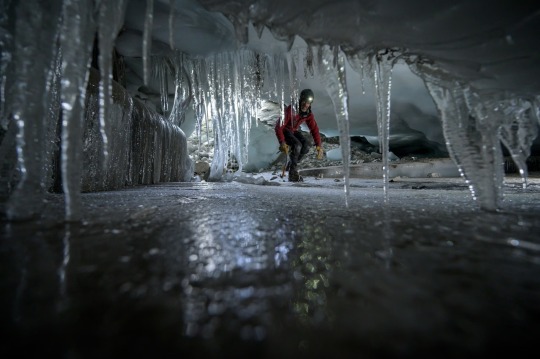
Jason Gulley navigates a cave in Nepal's Ngozumpa Glacier, stooping as he walks. Even experienced cave explorers struggle to descend caves covered in ice.
The caves formed where bands of debris-rich ice provided a weak spot that melt water exploited. The passages were often round, with a deep chasm cutting into the floor, indicating it was carved by gushing water that eventually slowed to a stream.
But glacier caves also differed in some striking ways.
As Gulley and Benn made repeated trips to Ngozumpa Glacier, they saw that narrow passages often squeezed shut from one year to the next—the glacial ice oozing inward like silly putty. Those passages melted open again the next time water from a draining lake gushed through.
These observations led Benn and Gulley to a theory—published in 2017—of how caves erode debris-covered glaciers.
“As those caves expand and collapse, they’re creating new depressions, that create new lakes, that create new caves,” says Gulley.
As this downward spiral continues, the depressions expand and deepen, forming ice cliffs that melt quickly because they’re warmed by sunlight. Warm melt ponds undercut the ice cliffs—crumbling them—exposing more bare ice.
In this way, a depression “can grow faster and faster the bigger it gets,” says Ryan Strickland, a PhD student studying caves at the University of Arkansas.
Strickland used a drone to measure 3,000 depressions on Ngozumpa Glacier. His analysis, published in August, suggests that depressions really do grow more quickly as they expand—consistent with Gulley’s theory that melt caves drive the process.
“It’s absolutely plausible,” says Owen King, a mountain glaciologist at Newcastle University in the United Kingdom, who has worked in this region. “The mechanisms that Ryan has described, we can definitely see evidence for.”
The melt water gushing through caves gathers in a massive lake near the glacier’s terminus. Spillway Lake is half a mile long. It is dammed by a massive ridge of rubble that the glacier piled up over thousands of years. As it grows, it could rupture that dam, sending several million cubic yards of water plunging down the valley.
In 1985, a glacial lake outburst flood eight miles southwest of Ngozumpa swept away 14 bridges, 30 houses, and a hydroelectric plant. This flood risk will increase as more glaciers give way to lakes.

Mere steps from Everest Base Camp, a pair of researchers drop into a glacier cave on Nepal's Khumbu glacier. Rising temperatures and melting ice lowered the ice surface at Everest Base Camp by a staggering 98 feet between 1984 and 2015.
A Remnant Cave Left High and Dry
When Gulley visited Ngozumpa Glacier in 2018 and 2019, he was shocked by what he saw. Very few caves remained. So much of the glacier had sagged down to the level of Spillway Lake, that melt water was no longer driven to flow downhill and create new caves.
They did find one fragment of a cave that Gulley first mapped in 2005. Back then its entrance was at the bottom of a depression. But now all that remained was a short section of cave piercing a ridge of ice.
Even as melt caves disappear from the lower reaches of Ngozumpa, they will penetrate higher up the glacier’s 22-mile length. Melt caves will eviscerate more and more glaciers—creating lakes that could release devastating floods.
“These caves are symptoms of dying glaciers,” says Gulley. “This is what almost all of the glaciers in the Everest Region are going to be turning into.”
1 note
·
View note
Text








having a normal one👍
#kinda cant believe we got a jamie crying scene and it was like That#i know it was kinda played for laughs (on the silly football comedy show?? noooooooo. shocker! shhh shhhhhh) but his reaction.....maaaaaaan#very unexpected. ig the only other time we've seen him cry was when he was in shock and also surrounded by a fuck ton of people#he was probably stifling that shit. versus it being with roy. he just kinda melts man. maaaaaaaaaaaaaaan#i know its like boiling point shit. having functioning relationships on the team at stake. the man city match. everything swirling#but just that versus him watchin the movie with the team like😐😐😐its just so telling innit#MR FACADE IN THE HOUSE. i don't know....hmmmmmmmmmm.....hmmmmmmmmmmmmmmmmmmmm#hes not got the words for it. is what im tryin to get at. (looks like i dont have the words for it either lmaooo)#his i dont knows and the comments about his dad stamping out his softness......😮💨when it bubbles up its like where do i put this#i havent slept maybe i will try and graft this into an actual tangible paragraph or maybe i will say fuck it and cave and write a fic#or maybe i will continue communicating thru impact font memes yeeeeaaaaaaa#jamie tartt#ted lasso#rot riffing
500 notes
·
View notes
Text
Xena's daughter in law is kind of a pain in the ass.


I get Xena is a family woman by season 6 but come on. Spend less time mentoring your violent daughter in law.
I like the Eve/Varia thing because their characters sure are parallel to Eve's Moms lol. Gayyyyyy. So so so so 🌈.

#wlw positivity#wlw ship#xena warrior princess#lgbtqia#xena#xena and gabrielle#xwp#xena & gabrielle#eve and varia#so so so gay#dangerous prey#remember when xena waltzs in that cave and says im a warrior princess#warrior mom?#well i melted#in fact still a mess on the floor#cookie holiday
168 notes
·
View notes
Text
It always makes me soft to think about the F/Os who typically are or seen as the big spoon be the little spoon. It's sweet to think about them being hugged from behind, held in your arms, or they fall asleep on your chest.
#OR when they refuse to be the little spoon until they finally cave one day and then just melt in your embrace.#f/o#fictional other#f/o community#self ship#self shipping#self ship community#f/o talk
55 notes
·
View notes
Text
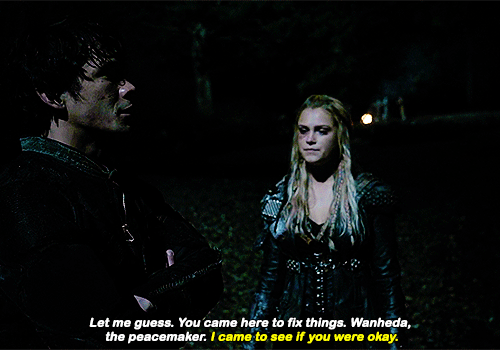













BELLAMY BLAKE WEEK 2023 ⇢ DAY 4: Favorite Comfort Moment
#bellarkeedit#bellamyblakeedit#clarkegriffinedit#the100edit#the100daily#bbaw23#tuserheidi#usersmia#usermoonchild#*#this is THE blarke hug for me!!#first of all bellamy really did not have the right to be so mad at clarke buuuuttt#its the way he instantly caves and lets his anger go#once she comforts him in the way that only SHE can#and the way she's been doing unconditionally for the past few days#after he's living with so much guilt and wretchedness#and she still believes so fundamentally in his goodness and redemption#and so he just melts. he melts when he realizes how much he missed clarke and what it was like to be truly understood#whew... 3b u will always be famous#wish i could have captured every single beautiful facial expression but#this scene is long enough as it is
87 notes
·
View notes
Text
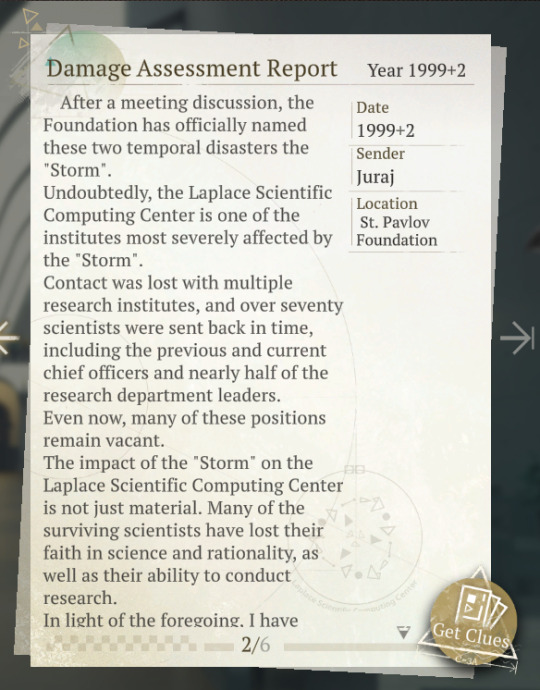

Consistent archival will make lore hunters happy.
#reverse 1999#the prisoners in the cave#sealed records event#we're getting more information on just how much impact the Storm has on humanity in first 4 years before Vertin became Timekeeper#I'm also interested in these policies placed on arcanists just as the first Storm hit#Could it be the same policy that allows the Foundation to take in arcanist children to serve under human government as soldiers?#Not one for political intrigue but if it's fictionally for world building I'm willing to melt my brain to understand it
37 notes
·
View notes
Note
What's your fav character and dynamic in MSA?
Btw I really love your style mate, keep it up!
THANK YOU !!
this will come as a surprise to no one but lewis. i was one of those girls growing up that HATED pink (because i didn't want to be like Other Girls) and no joke lewis made me like pink again. he is also just Very fun to draw cuz he's made of so many different shapes, plus his hair is silly
finding a favorite dynamic for me is really hard because i absolutely cannot choose just one- i've been lewthur posting for literally years so that's kind of a given, but i also really enjoy arthur and vivi's dynamic both pre/post cave!! they're definitely best buds who, with their combined brain power, do the wildest shit known to man.
#ask#muscovitez#msa#arthur and the lewis' family is another big one#post cave to clarify#him practically destroying himself to find their son#and they're like Don't do that#and take care of him when he visits#yknow#my thoughts and ideas about characters and their dynamics are just a big melting pot of my own and a bunch of other people#cuz y'all come up with some REALLY good stuff#that i think just makes sense#anyway
23 notes
·
View notes
Text

Ehehehhe boyz are prtty
#minecraft story mode#mcsm#mcsm fanart#jack mcsm#mcsm jack#im so gay.#LOOK I SAW SEVERAL PICS O CHARACTERS W LIKE THEIR FACES OR SOME OTHER INJUY MELTING LIKE THIS#I CAVED#I CAVED FOR M E N#this turned my lesbian friend straight / j#themintman#Clemont_ine
34 notes
·
View notes
Text
The way I have the beginning and ending of my Everlark fic done, but the middle is nowhere to be seen.
#they don’t tell you the middle part is the hardest to write#you know#the bulk of the dam. fic#it’s not even that long HAHAHAHA#it doesn’t help that I’m melting in my seat#I’m installing my AC tomorrow#everlark#I’ll#probably just skip to them in the cave and figure the rest out later#HAHA
8 notes
·
View notes
Text
Doc Ock Remi who uses cheese instead of tech 😭 what was I planning with this? Nothing, I just thought it was a funny idea

#his canon event is that he eats the cheese-string pack and goes back to normal after realizing that’s possible/hj#he got the backpack from the Cheese Caves (he left a 0 star review after that experience)#Kiff OC#I should probably sleep now it’s like 2 AM 😭#I should mention he can’t take it off bc it melted onto his clothes (he couldn’t wash the cheese out 💔)
12 notes
·
View notes
Text
SICKENING SIDE EFFECTS of getting good at gw2 NOW as a mirage main like. i didn’t feel the spec slowing and weakening as it happened with each 2022-23 balance patch UNTIL i started doing endgame pve & running scrapper, and now that i’ve eaten from the tree of knowledge, prem feels awful to play. even in open world, no damage, no support, about to have its evasion gutted with this next patch. 5 years of emotional investment in a character and a 🤌🤌🤌PERFECT🤌🤌🤌 triumph in fashion wars (i shant be humble about this. look at him) just to not be able to use him at all in strikes or raids which are the main things i’m doing, feeling silly even bringing him to guild missions and metas. like. every build is completely bled out. but there’s no other class as chaotically mobile and unpredictable and sexyhot as axe mirage so. now what
#this is completely a gamer vent post i’m worked up :’(#like i do rly like specter & scrapper but the satisfaction of distorting through attacks and melting enemies on mirage in 2019. incomparable#& the spasmic movements of an evadey axe build is SO. never gets boring unlike spamming 3 on specter or smacking a boss’s shins endlessly on#scrapper.#do i just cave and get into ele since they’re getting all the buffs lately and are the only thing as challenging as mes??#i think ele magic is so ugly :’((#advice welcome#gw2#I DID A LEGENDARY FOR PREM. 😡😡😡😡
11 notes
·
View notes
Text
OH N ANOTHER THING . . . coraline in the cp77 verse is completely disconnected to her own name , which is sad , because believe it or not cora actually deeply adores it . but she just . . . isolated herself , went solo , always being adressed as BLUE &. eventually nobody knows her as her birth name . it's gone , she hardly remembers it herself .
#v: cp | to be decided.#nhgnhgnHGNHGNHGNHnghnghnghn:(#what if i was suicidal ( i did all this myself )#oh to tuck a stand of hair behind her ear and softly whisper 'coraline' and watch her melt and cave n see the fear in eyes
2 notes
·
View notes
Text
genuinely I think the only fromsoft games to *not* have a poison swamp are like. a couple early kings field games and armored core
#raven.txt#and no. falling into water and immediately dying does not constitute poison or swamps#neither does an artic cave filled will coral melting your armor.#*with coral
2 notes
·
View notes
Text
why doesn’t dazai ever wear his fucking coat properly
#my dude put your damn coat on you’re gonna catch a cold!!!!!!!!!!#brain rotting for this man#rotting!!!!!!!!!!!!!!!!#skull melting caving in and turning to mush#anyway i have so many dazai asks to get to and what am i doing????????? watching dead apple again#in ENGLISH this time#inky.bsd
7 notes
·
View notes
Text
once again. i sincerely wish for the absolute motherfucker of a neighbour smoking a cigarette in their window 0:30 am to choke on it while their at it.
#i hate people so much#my whole fucking cupboard of a flat smells like cigarettes#moments like these make me wanna move out to a cave in some v.remote location.#stink your own flat you asshole#close the window lady you might propose#i can't or i will melt into my bed its so bloody hot 😩#blah blah text post#lady whines#killing maiming biting etc
5 notes
·
View notes
Note
i want you to know that youve singlehandedly founded all of my interest in caves,, its so cool when you talk about them
WAIT REALLY……. thats so cool. i need to be Weird about caves as much as i can or else i start drying out like a plant that hasnt been watered. im glad you like my feverish ranting :D
#people talking to me#i have NO idea where this fierce love for caves came from#it was just the cool thing we did whenever someone came out to see us#then i had a few cool experiences in caves (guy accused me of being a vampire; lady said i was really pretty; drank cave water etc)#and my brain just melted into it#theyre just so aggressively ALIEN#theyre actively hostile to life (which; of course; gives not one fuck and lives there anyway)#but theyre just as gorgeous and mind blowing and diverse as any other biome on earth#the call of the void is very strong
6 notes
·
View notes